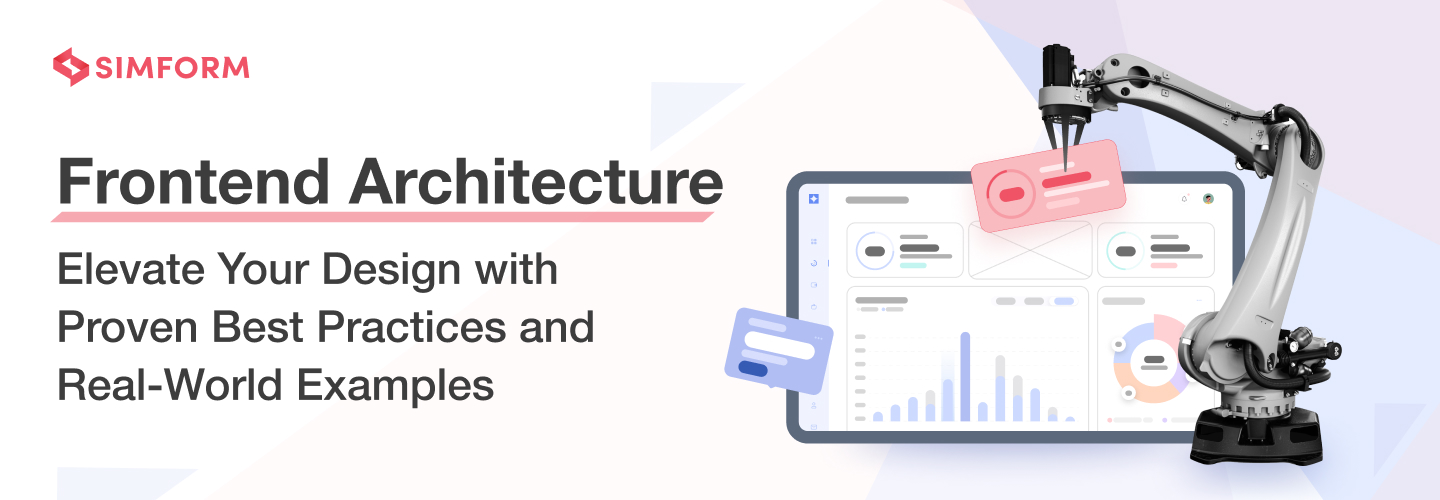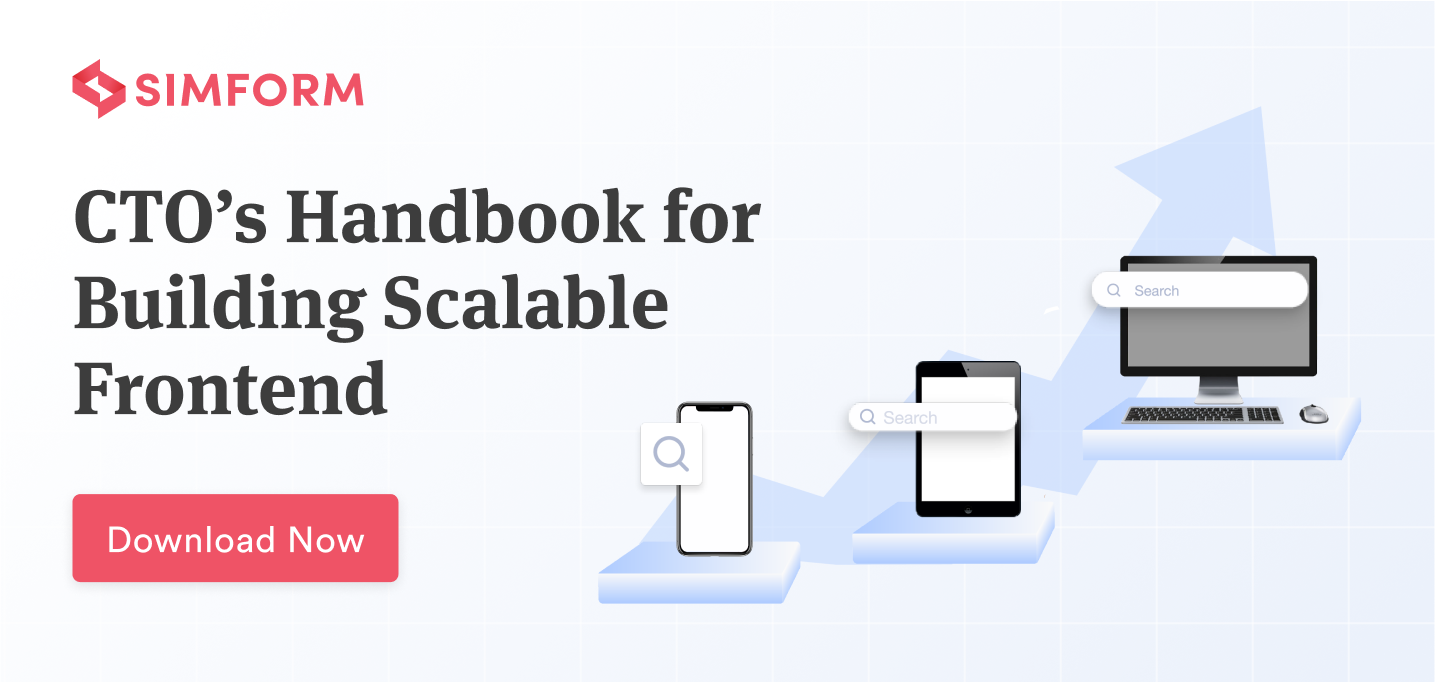Frontend Architecture and How to Improve its Design
When Airbnb introduced two new features, Experiences and Places, it considered redesigning its frontend architecture.
The goal here was to create a free-flowing navigational experience that would enable guests to expertly move between pages on the web apps. And what better way to accomplish this than switching to React? In addition to this, it developed a Design Language System (DLS) to speed up the iteration lifecycle and Airshots to access thousands of screen permutations instantly. Ultimately, the team was able to manage tech stack reconfiguration, client-side routing, code splitting, and lazy loading.
Many organizations like Airbnb struggle to figure out how to design a frontend that serves millions of users with a seamless experience. Rethink your frontend architecture that functions flawlessly into different devices, environments and makes an effortless user interaction.
Let’s begin with the definition before leaping to this reform.
What is frontend architecture?
Frontend architecture comprises a bunch of practices and tools that upgrades your application’s code quality. What’s more, it also presents you with the opportunity to create a productive, scalable, and sustainable workflow.
Let’s take the example of building a house. First, architects create schematics of the house for better structure and navigation. Then you need labor to lay down the brick and mortar foundation and do the construction work.
The same goes for the software products where frontend architects build a system for frontend developers to code. You can also call it a standard against which the code is being tested. It sets a tone for writing code and remains a guide to the developers throughout the development, resulting in impeccable user experience, zero disappointments from users, and quality software product development in less time.
Why do you need a frontend architecture?
We have a ton of reasons to convince you to rebuild your architecture, but let’s approach this slowly.
The first is to establish coherence between UX and UI by eliminating more refreshes between views, selecting sizes and designing the layout of interaction elements, and deciding other predefined user elements that add to the app accessibility. This keeps your potential users glued to using your application, and your app now has effortless user interaction.
Secondly, let’s think of a shopping mall with excellent image-based navigation, welcoming space, visual markers, and things that help customers navigate the building. Places like these are more likely to be visited compared to congested architectures. In web and mobile apps, good navigation means using white space, easy-to-understand language, appealing color combination, interlinking of links that redirect users to the most visited pages, and other design principles that result in an accessible UI.
Lastly, to make frontend modules independent of each other, you need a design that divides and displays the information as required. To meet these requirements, you need to comprehend design principles and expert architects that provide the required structure for frontend developers to code upon.
Example 1: Pinterest
Pinterest generated 44% user-generated ad revenue, increased core engagement by 60%, and time spent by 40%.
Pinterest, for one, had a slow web experience and only turned 1% of users into sign-ups, logins, and other native app installs.
Once it rebuilt its mobile web experience using React, Redux, and webpack, it saw noticeable changes in its business interests in just 3 months.
It trimmed down the Javascript code and revamped the traditional platform to a progressive web app as a part of the frontend redesign and reduced network transmission and Javascript compile time significantly in the latest app. It also underwent some additional changes like navigation transitions, image optimizations which helped launch a faster and more responsiveapplication.
Benefits of frontend architecture
Frontend architecture enhances user experience and web application performance. A well-structured and modular frontend architecture enables developers to improve code maintainability, scalability, and reusability. But these are not its only benefits, there are a few more:
- Modularity: Breaking down complex frontend code into reusable components enhances code reusability and maintainability.
- Separation of Concerns: Separating presentation and business logic promotes code organization and collaboration among the software development team.
- Technology Independence: Adopting different technologies for different application parts allows flexibility and innovation.
- Faster Development: Streamlined development process through independent component development.
- Targeted Testing: Easier and more focused testing of individual components for thorough quality assurance.
Best practices of frontend architecture
To ensure a smoother workflow in frontend development, one needs to follow a couple of best practices, like using a responsive design framework, a good building tool, a testing tool, a consistent coding style, and convention.
Along with this, you can follow some more best practices for frontend architecture:
1. Optimize the design-to-development handoff
To optimize the design-to-development handoff, you can:
- Create comprehensive design documentation that includes wireframes, mockups, and style guides.
- Use collaborative tools like Figma or InVision for seamless teamwork and sharing of design assets.
- Involve developers early in the design process for valuable insights and to address technical limitations.
- Conduct regular design reviews with designers and developers to ensure alignment and feasibility.
- Develop a standardized checklist for the design handoff to maintain consistency.
- Implement a design QA/QC process to ensure error-free and consistent designs.
- Provide post-handoff support to address questions and challenges during implementation.
Following these steps improves collaboration, reduces friction, and enhances efficiency in the design-to-development handoff process.
2. Supercharge web development with trendy frontend CSS frameworks
When you’re involved in front-end development, opting for a CSS framework is considered a top-notch approach to boost your efficiency. You can choose a well-established front-end CSS framework like Bootstrap, Foundation, or Material Design.
These frameworks provide pre-designed components that eliminate manual coding and ensure responsive web design compliance, resulting in faster website construction and seamless rendering across various devices.
3. Master the art of interface design
Instead of solely relying on the design-to-development approach, adhere to standard design practices. For example, create interfaces that adhere to the specified design elements, including layouts, colors, typography, and spacing.
Ensure you maintain open communication lines between the design and frontend development teams. This is crucial so that you don’t end up with a UI that cannot be developed or violates the requirements of a target platform.
4. Ignite innovation with the dynamic duo of Developer-Designer
A good front-end practice is having both teams collaborate and discuss the UI/UX details before designers create digital designs. This way, the designs will always fit within the technical limitations, and the developers will know exactly what they need to build.
Many font-end development companies use Figma, a dynamic software, to enhance collaboration. It enables developers to access up-to-date designs and get accurate specifications.
Figma integrates code snippets across programming languages, enabling users to incorporate and share them for feedback and collaboration effortlessly. It’s like a secret weapon for developers! Do, try it out!
How to re-evaluate your frontend architecture?
With technology constantly evolving and users expecting more, it’s essential to give your frontend a fresh look and ensure it’s up to modern standards.
Taking the time to re-evaluate can work wonders, boosting performance and giving your users a top-notch experience. The tips below are part of our considerations to help you re-evaluate your frontend architecture. So, let’s roll up our sleeves and get started!
- Assess the Current State: Evaluate your frontend setup, identifying strengths and weaknesses. Pinpoint performance issues and maintenance challenges. This assessment lays the foundation for your redesign.
- Embrace Modularization: Divide your code into reusable components. Enhance maintainability and foster collaboration. Develop, test, and update components individually for efficiency.
- Leverage Component-Based Frameworks: Use frameworks like React or Angular. Simplify frontend development with reusable components to streamline efforts and improve code reusability.
- Optimize Performance: Prioritize performance optimization. Minify and bundle code, optimize images and use caching. Implement lazy loading and prioritize critical content for a smooth experience.
- Test Rigorously: Incorporate unit, integration, and end-to-end tests. Automated testing catches bugs early, ensures stability, and saves time. Consider continuous integration for streamlined processes.
- Plan for Scalability: Design a scalable architecture. Prepare for growth with cloud solutions, serverless architecture, and microservices. Handle increased traffic and evolving requirements with stability.
Why and Where Should you Use React for Web Development?
Steps to improve your frontend architecture design
Frontend architecture design is like giving your web application a superhero upgrade! It’s all about creating a web application that’s well-structured and easy to maintain. Here are some steps that can be taken to improve frontend architecture design:
- Refactor the code: Turn complex and inflexible code into clean code and reduce the overall technical debt of the project by refactoring it. This kind of complexity often happens due to tight deadlines, but refactoring can help improve the quality of the code and make it more maintainable.
- Harness ‘micro frontends’ for domain-driven design: Utilize micro frontend architecture to divide your application into smaller, interconnected entities. Implementing a domain-driven design with micro frontends simplifies complex applications, enables efficient data and event interaction, and facilitates faster deployment and upgrades.
- Use component-based architecture for frontend engineering: Component-based architecture is famous among frameworks like React and Angular as it encapsulates one feature to become shareable among other modules. Plus, it enables feature sharing among modules and supports animations in modern apps. It offers improved control, faster development, lower maintenance costs, and improved reliability.
- Make CI/CD work for you: Supercharge your CI/CD with our parallelism and turbocharged builds. Take control of your development environment and witness the magic as you lead the build and run stages. Unify engineering and product teams with Design Language System and create seamless collaboration and results.
Discover the strategies from the front-end scaling journey of 30+ companies worldwide
Conclusion
A good architecture design is a building block of any frontend architecture.
Redesigning of frontend architecture for code reusability, better maintainability, and standard principles speed up adding functionalities in applications later. End-users benefit from more accessible, handier apps and can enjoy faster upgrades with the latest features. The number of active users increases as they could effectively use the system as happened in Pinterest’s case; it received tremendous business growth after making a PWA app. app.
We, at Simform, have partnered with a host of companies to evaluate their frontend architecture needs and find top-notch architects to add artistic sense to their product design.
Reach out to us for an in-depth analysis of your existing frontend architecture and the best possible solutions to revamping your app experience.






